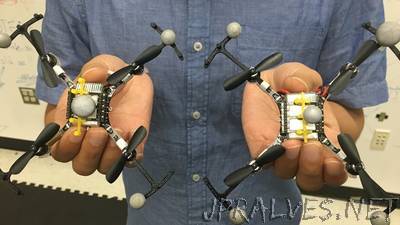
“Georgia Institute of Technology researchers have created a team of free-flying robots that obeys the two rules of the air: don’t collide or undercut each other. They’ve also built autonomous blimps that recognize hand gestures and detect faces. Both projects will be presented at the 2017 IEEE International Conference on Robotics and Automation (ICRA) May 29 – June 3 in Singapore. In the first, five swarm quadcopters zip back and forth in formation, then change their behaviors based on user commands. The trick is to maneuver without smacking into each other or flying underneath another machine. If a robot cuts into the airstream of a higher flying quadcopter, the lower machine must quickly recover from the turbulent air or risk falling out of the sky. “Ground robots have had built-in safety ‘bubbles’ around them for a long time to avoid crashing,” said Magnus Egerstedt, the Georgia Tech School of Electrical and Computer Engineering professor who oversees the project. “Our quadcopters must also include a cylindrical ‘do not touch’ area to avoid messing up the airflow for each other. They’re basically wearing virtual top hats.” As long as the Georgia Tech machines avoid flying in the two-foot space below their neighbor, they can swarm freely without a problem. That typically means they dart around each other rather than going low.”
